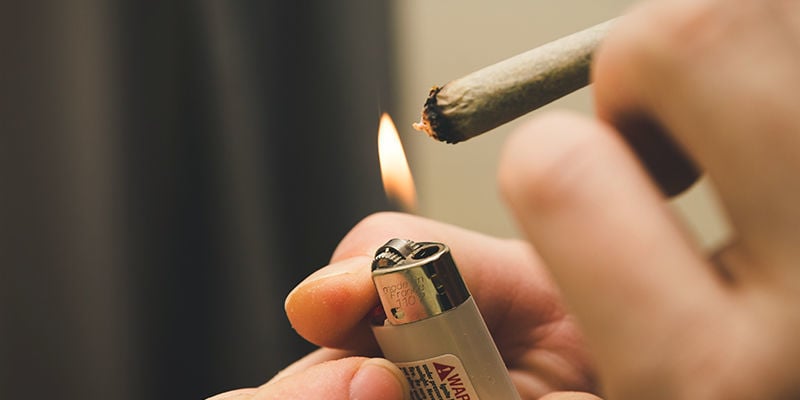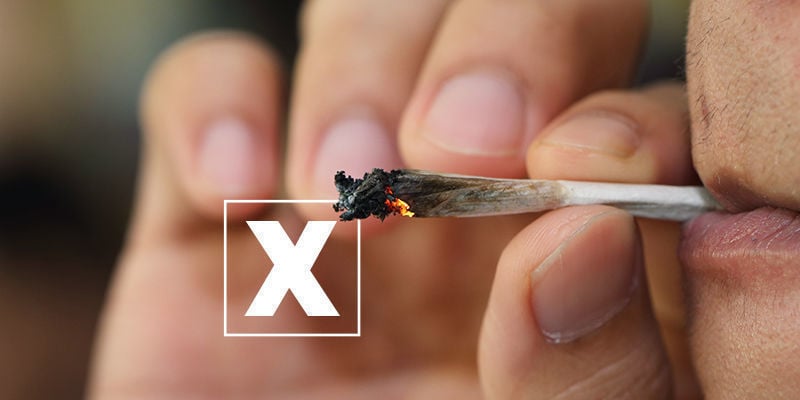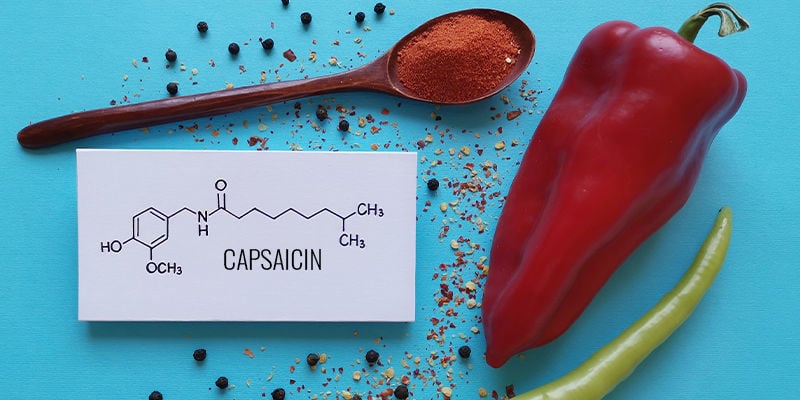
How Capsaicin Could Soothe Cannabinoid Hyperemesis Syndrome
Capsaicin is an effective topical treatment for many conditions involving pain. But could it be used to treat cannabinoid hyperemesis syndrome? This rare condition causes nausea and recurrent vomiting, and is caused by chronic cannabis consumption. Find out about it here, and see whether capsaicin could help.
Cannabis is known for its ability to affect feelings of nausea and sickness, hence its derivatives are prescribed to patients undergoing treatments such as chemotherapy. What's less commonly known is cannabis hyperemesis syndrome (CHS), a rare condition caused by cannabis. Depending on how advanced this condition gets, it can go from affecting quality of life to being entirely detrimental to one’s health.
Today, we look at how effective topical capsaicin creams could be for mitigating the symptoms of CHS.
What is cannabis hyperemesis syndrome?

Cannabis hyperemesis syndrome, or cannabinoid hyperemesis syndrome, is a fairly uncommon condition caused by chronic marijuana use. Affecting the digestive system, CHS can cause ongoing nausea and, if left untreated, can lead to continuous bouts of vomiting.
Unsurprisingly, feeling nauseous and vomiting on a regular basis have a fairly severe impact on a person’s quality of life. Fortunately, this condition will abate if cannabis consumption ceases. Unfortunately, it seems that once someone develops CHS, it is likely to return if cannabis use is continued.
However, in this article, we look at whether capsaicin, the compound that makes chillies spicy, could help. More on this shortly.
Symptoms of CHS
Symptoms of CHS can be split into two stages.
The first is known as the prodromal phase, and is characterised by nausea, but does not include vomiting. Symptoms of the prodromal phase are:
- Early morning nausea
- Abdominal pain
- Fear of vomiting
- Regular eating is unlikely to be interrupted
- Can last weeks, months, or years
The second stage is known as the hyperemetic phase, and is characterised by regular vomiting. The symptoms of the hyperemetic phase are:
- Ongoing nausea
- Repeated vomiting
- Abdominal pain
- Reduced food intake
- Weight loss
- Dehydration
If people suffering from CHS stop using cannabis, then there is also a recovery phase. Lasting weeks or months, this phase will see a reduction in symptoms, and eventually total remission.
What causes CHS?

Exactly what causes CHS is unclear, although generally it is suspected that it’s caused by a combination of genetic factors and overstimulation of the endocannabinoid system (ECS).
The ECS runs throughout the body, and is a network of channels and receptors found in the brain, nervous system, and immune cells—and the gut and intestinal tract.
The cannabinoids in cannabis can bind to or block certain channels and receptors in the ECS, and the full effects of this are unknown. However, it seems that in certain, rare instances, one effect can be CHS.
Though not proven, there are two parts of the ECS that have been identified in the context of CHS. For a time, it was thought that cannabis' interaction with CB1 receptors was responsible for causing CHS. However, more recent research suggests that decreased signaling of the TRPV1 receptor may be responsible—as this receptor is found in the intestinal tract (Moon, Buckley and Mark, 2018). It’s worth noting that the TRPV1 receptor is a vanilloid receptor. We’ll return to this later.
How common is cannabinoid hyperemesis syndrome?
CHS is fairly rare, although as a newly discovered condition, it’s likely that there are many cases that are misdiagnosed, meaning the true occurrence of CHS is probably higher than recorded.
There are a couple of factors that make CHS more likely to occur. First, chronic cannabis use is the main risk factor. The odd smoke here and there won’t cause CHS, only chronic consumption. More than once a week is considered to be a risk factor, but in most cases only very heavy users are at significant risk.
The second risk factor is the age at which people begin to use cannabis. Those who start during adolescence are at greater risk than those who start in adulthood. The reason for this is unclear, but it may be that using cannabis during adolescence can interrupt natural development.
Current treatments for cannabinoid hyperemesis syndrome

At present, there aren’t many existing treatments for CHS. The only known means to actually cure the condition is to stop using cannabis. If you don’t do this, it will continue, and treatments will have very limited benefit.
However, there are some treatments that can help to ease the symptoms while you attempt to stop using cannabis and go through the recovery phase.
These are:
- Antihistamines
- Antipsychotic medications
- Topical capsaicin cream (more on this shortly)
- Painkillers
- Hot baths or showers
Can capsaicin help with cannabinoid hyperemesis syndrome?

Capsaicin cream may seem like an unlikely treatment, but it demonstrates some benefits regarding the symptoms of CHS.
What is capsaicin?
Capsaicin is the compound in hot chilli peppers that gives them their heat. Though it’s most famous for its spicy properties, and crucial role as a culinary ingredient across the world, there’s more to capsaicin than just heat.
Capsaicin is actually a vanilloid agonist as well—meaning it binds to vanilloid receptors, such as the TRPV1 receptor, which is part of the “expanded” endocannabinoid system. More generally, capsaicin is known to be an effective treatment for pain, prescribed in the form of topical ointments.
Capsaicin vs capsicum
Capsicum is the generic name for chilli peppers. Capsaicin is the chemical they contain that gives them their spice.
It’s unlikely that just rubbing a spicy chilli pepper on your body will give you the results you’re after. It’s worth talking to a doctor and using a prescribed topical capsaicin cream.
Research on capsaicin for CHS
There’s a fair amount of research regarding capsaicin's efficacy for treating CHS. Though it should be noted before we delve deeper, it will not cure your condition! If you are suffering from CHS, the long-term goal must be to stop using cannabis, otherwise it won’t go away. All capsaicin can do is limit the symptoms while you attempt that process.
That being said, the first piece of research centres on what we’ve already mentioned—the TRPV1 receptor. It posits that, if CHS may in part be caused by a reduction in TRPV1 signalling, then increasing the activity of this receptor might help to mitigate some of the symptoms (Moon, Buckley and Mark, 2018).
Before we get too excited, though, it should be mentioned that the above study is a case study, meaning it focused on a single individual only. Therefore, though the findings are interesting and warrant further research, drawing conclusions from them is not currently possible.
Another case study has similar findings. A 41-year-old woman suffering from CHS for years saw dramatic relief within 24 hours of being given a topical capsaicin treatment, with no return of symptoms (Aziz, 2020). Once again, it’s hard to draw definitive conclusions from case studies. Identifying capsaicin as the cause of remission is not possible from a single case. This patient was in the hospital at the time, and was prescribed other medicines as well, so isolating variables is not possible.
A third study, also conducted in a hospital, shows that two treatment-resistant adolescents with CHS reacted well to topical capsaicin treatment (Graham, Barberio and Wang, 2017). This study also highlights the potential mechanism of the TRPV1 receptor, once again suggesting that it could be responsible, at least in part, for causing CHS.
Finally, a review of 11 studies concludes that though the methodological rigour of existing studies is low, the efficacy of capsaicin appears to be higher than comparable treatments, and is likely an effective first-line treatment for CHS (McConachie, 2019).
This review indicates that capsaicin is likely safe, and effective to some degree. In total, across the studies, it notes that there are 18 cases in which capsaicin is cited as an effective treatment for CHS. It also notes that much more rigorous studies are necessary before we can ascertain how effective capsaicin actually is for treating CHS.
How capsaicin cream works

Capsaicin cream is transdermal, meaning it is absorbed into the bloodstream via the skin.
You can apply capsaicin cream to any unbroken skin that does not contain a mucous membrane. So keep it away from the eyes, nose, mouth, and genitals—this will hurt! Moreover, regular use on a single piece of skin will see a reduction in the tingling feeling it causes, as the skin becomes tolerant to its irritating effects. However, this does not mean that its pain-relieving properties are less effective.
CHS: Is there another explanation?
There may be many causes for vomiting, but CHS involves recurrent vomiting caused by regular cannabis use. Though the exact mechanisms of the condition are unknown, it seems possible that the TRPV1 receptor is a crucial link. However, much more research is needed to gain a better grasp on CHS, as it's only recently been identified.
If you know, or suspect, you suffer from CHS, then quitting cannabis is your best (and only real) bet in ridding yourself of this condition. The above treatments will help to lessen the symptoms while you attempt to quit, but ultimately abstinence is the only real solution.
- Aziz, Ansar, Waheed, Tayyab, Oladunjoye, Olubunmi, Oladunjoye, Adeolu, Hanif, Midhat, Latif, & Fareena. (2020/11/27). Topical Capsaicin for Treating Cannabinoid Hyperemesis Syndrome - https://www.hindawi.com
- Graham J, Barberio M, & Wang GS. (2017 Dec). Capsaicin Cream for Treatment of Cannabinoid Hyperemesis Syndrome in Adolescents: A Case Series - https://pubmed.ncbi.nlm.nih.gov
- McConachie, S. M., Caputo, R. A., Wilhelm, S. M., & Kale-Pradhan, P. B. (2019). Efficacy of Capsaicin for the Treatment of Cannabinoid Hyperemesis Syndrome: A Systematic Review. The Annals of pharmacotherapy, 53(11), 1145–1152. - https://journals.sagepub.com
- Moon, A. M., Buckley, S. A., & Mark, N. M. (2018). Successful Treatment of Cannabinoid Hyperemesis Syndrome... : ACG Case Reports Journal - https://journals.lww.com
-
 5 min
27 January 2022
The Surprising Benefits Of Combining Cannabis And Hot Peppers
Cannabis chills out the body and the mind. Peppers, in contrast, send a jolt through the central nervous system and wake up the senses. However, despite their differences, these two plant species...
5 min
27 January 2022
The Surprising Benefits Of Combining Cannabis And Hot Peppers
Cannabis chills out the body and the mind. Peppers, in contrast, send a jolt through the central nervous system and wake up the senses. However, despite their differences, these two plant species...
-
 9 min
5 October 2021
Top 15 Hottest Peppers In The World (2025 Edition)
How does a chilli become the hottest in the world? We take a look at the 15 most potent peppers you'll want to get your hands on—or perhaps avoid, depending on how well you can handle the heat! We...
9 min
5 October 2021
Top 15 Hottest Peppers In The World (2025 Edition)
How does a chilli become the hottest in the world? We take a look at the 15 most potent peppers you'll want to get your hands on—or perhaps avoid, depending on how well you can handle the heat! We...
-
 4 min
5 August 2021
Hot Peppers And The Scoville Scale
There's no denying the appeal of spicy food. Whether you're keen on Mexican delicacies, Pad Thai, or Vindaloo curries, they have one thing in common; peppers.
4 min
5 August 2021
Hot Peppers And The Scoville Scale
There's no denying the appeal of spicy food. Whether you're keen on Mexican delicacies, Pad Thai, or Vindaloo curries, they have one thing in common; peppers.
-
 4 min
11 June 2021
Can Black Pepper Help Manage the Effects of Cannabis?
Both black pepper and cannabis contain the terpene and dietary cannabinoid beta-caryophyllene. This molecule activates the CB2 receptor of the endocannabinoid system and produces relaxing and...
4 min
11 June 2021
Can Black Pepper Help Manage the Effects of Cannabis?
Both black pepper and cannabis contain the terpene and dietary cannabinoid beta-caryophyllene. This molecule activates the CB2 receptor of the endocannabinoid system and produces relaxing and...












 United States
United States










